

Searching for the Structural Causes
THE PAIN MAY NOT BE WHERE THE PROBLEM IS!
If you have been directed to this section, your structural inflammation score was moderate to high, and your pain is caused, at least in part, by structural issues, or something wrong in the bones, muscles, or nerves, most often generated by habits and posture that are not “structurally sound.”
As you move forward with your structural diagnosis, you should note that back pain is really spine pain. All nerves exit the spine so improving the function of the spine can have a profound impact on your entire body. I still receive bewildered looks when a patient’s knee or wrist pain is reduced by treating his or her back. When you expand your knowledge and understanding of your spine and realize the impact a balance or imbalance can have on various parts of the body, you will grasp a very important concept in structural treatment. Back pain can refer to and include most any type of pain.
You see, there are two types of structural back problems:
To understand this concept, visualize your spine as a shoelace. Take that shoelace and staple one end of the lace to a piece of paper and let the other end hang down. This is your spine. Now start twisting the loose end of the shoelace. If you twist long enough, you’ll find that the entire shoelace—as well as the piece of paper (which represents the rest of your body)—gets all twisted. Now you understand that what happens in one location in your spine most definitely affects the rest of your body. The spine is completely integrated and relates to your entire body. If you view your body as a compilation of separate and distinct parts, the likelihood of ridding yourself of back pain forever is nearly impossible. As you begin to understand your structural diagnosis, keep in mind that the body is interconnected and your treatment may target a spot where you don’t particularly feel the pain.
• • •
As a professional tennis player and teacher from Mali, Africa, I had been suffering from severe groin pains. Playing tennis was unthinkable—just standing and feeding tennis balls during my lessons was downright painful! To get through the day, I had to take tons of anti-inflammatories, even though the medication was really messing up my stomach. I had been to the best doctors in New York City and they told me to rest, ice, and take the anti-inflammatories, but after three months, it was only getting worse.
When I gave Dr. Todd Sinett a tennis lesson, I never thought that my life would change forever. Dr. Sinett saw how I was limping and wearing this enormous ace bandage and he asked about my problem. I told him about my severe groin pain and how long it had been going on. He was kind enough to offer to examine me at his office to see if he could help me. I certainly didn’t think he could help but considering the options, why not? Once he examined me, Dr. Sinett explained that he didn’t think the pain was a groin problem, but rather a problem coming from my foot. He adjusted my foot, and I immediately felt better. He did this two more times at follow-up appointments, and I was 100% cured. Since I work on my feet all day, it made sense that an imbalance in my foot could radiate all the way up my leg and into my groin. Dr. Sinett has turned out to be a great friend and an inspiration. I have gone on to open my own tennis club and certainly could not have done this without feeling better. I am a living example of how the Sinett method changes lives for the better!
Moussa Drame
Compensatory/global imbalances are the most common sources of pain. These imbalances come from five specific spinal “choke points,” or places in the body that affect not only the spine but the entire body. In addition to being the most common, they are the easiest to fix. The problem is that they are also the most overlooked, which explains why you’ve been suffering for so long. Finding these global imbalances is the key to treatments that have long-lasting impact. Just as in in building a house (you don’t put the floors down until the walls are up and painted), there is a natural order of healing that must be followed. All global/compensatory imbalances must be corrected first before addressing a patient’s localized problem. Once you have removed the global/compensatory issues, the majority of patients feel significantly better, necessitating less work to be done on the localized issue.
Unfortunately, insurance companies only cover the examination and treatment of the area where the patient is suffering and complaining of pain, but when evaluating one’s spine and back, a physician must examine a patient from head to toe. If you have imbalance in any of the five choke points, you will not be able to rid yourself of back pain. Regional exams such as only examining a patient’s lower back simply won’t work. The feet, the pelvis, the core/mid-thoracic region, the neck, and the temporal mandibular joint are the five “choke points” that affect the entire spine. Remember, the problem for most is not the back. The structural problems for most patients are actually occurring in one of these five choke points:
CHOKE POINT #1: The Feet
The foot is constructed with three arches which, when properly maintained, give exceptional supportive strength. These three arches form a supporting vault that distributes the weight of the entire body.
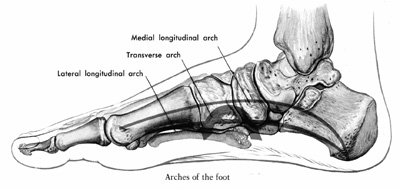
Source: Posturepro
But for many people who suffer from back pain, certain areas within their feet do not carry their end of the bargain, causing an imbalance that reverberates all the way up the spine.
The pen trick is a great way to demonstrate how a small imbalance in the foot can affect a seemingly unrelated body part. Choose a partner with good arm and shoulder function. Have him hold his arm out to the side and try to push his arm down with some mild to moderate pressure. The person should be able to hold his arm up against the resistance. Once you see that this person is able to do this, place a pen under one of his feet and have him stand on it. Retest the muscle strength. The strength should be dramatically reduced. While this sounds like hocus pocus, it will actually work on every single person. Why? It’s based on normal neurology. There are messages that go from the brain throughout the body and messages that go from the body back to the brain for interpretation. These messages or impulses are called afferent and efferent impulses (don’t worry, I won’t get too technical). So what is happening when the foot is standing on the pen? The foot sends the message to the brain that it is off-balance, and when the body is off-balance, the entire muscular system can’t function optimally. These neurological impulses are the same reason why a pebble in your shoe becomes so painful or you know to pull your hand away from a hot stove. In the pen trick, the brain easily tells the foot to get off of the pen in order to re-center itself, but when there is a habitual, unconscious imbalance (caused by poor footwear, bad posture, or something else), the brain can’t give a clear message, so it’s up to you to tune in and fix the problem.
There are several ways to determine if you have an imbalance in your feet:
Here’s one patient’s story about how she tuned into what her feet were telling her and consequently discovered a simple solution to her problem. The point of this story is to show you how interconnected your body is and also to give an example of how the body speaks a language.
• • •
MY FEET WERE CAUSING ME PAIN!
At the end of a work day, I would literally feel as if I had no strength in my legs. My knees would ache, and my feet and my back would be sore. I could not wait to get home. I thought everyone felt this way after a day of standing on their feet, but Dr. Todd told me he was on his feet all day too and he felt fine. He suggested orthotics, or molded insoles. With orthotics in my shoes, I regained balance in my feet and all the strength returned to my legs, without any pain in my feet, back, or knees. This was a complete life changer for me.
Erin Weissman
Today, appearance seems to take priority over function. Back pain caused by poor shoes is much more frequent during the warm summer months or in warmer climates because people tend to wear flip flops, open-toe shoes, and sandals. Women tend to suffer even more; heels that are higher than three inches put too much of your body weight on the front of the foot, which can cause calluses, bunions, corns, and hammertoes and strain your arches. Flats don’t support your arch or Achilles tendon and if you wear them too frequently, can cause your foot to become pronated, or flattened. A laced up or strapped shoe always provides more support than an open back shoe.
Still, shoes are generally only designed for the mass public. A portion of the population won’t function well in shoes made for the masses and will need a shoe designed and molded specifically for their unique feet. Orthotics work by customizing your sneakers, shoes and even high heels so that your foot sits properly in the shoe and is therefore able to strike properly. There are full and half orthotics. If you want to try an over-the-counter orthodic, the brand I like is Walkfit. They are significantly less expensive than a fully customized one. However, if you want to invest in a customized product, the orthodics I use are made by Footlevelers. The Footleveler orthotic is made by getting either a mold or a computerized foot scan of your weight distribution while standing. Footleveler designs the orthotic specifically for your feet, allowing you to evenly distribute your body’s weight. Some chiropractors and podiatrists will make a mold of your feet. Professionally made orthotics can be costly, from $200 to $800, although some health insurers cover a portion of the cost. Just make sure there is a return policy in case they aren’t a perfect fit!
CHOKE POINT #2: The Pelvis
The pelvis is the lower most part of the spine. I describe the pelvis as the foundation of the house with the head, neck, and shoulders representing the second floor. Just imagine the far-reaching effects a crooked foundation can have. Within the pelvis are your hips. If your pelvis is not aligned properly, it can easily affect your hips and your entire lower extremity including your knees and legs. It is extremely rare to be born with one leg longer or shorter than the other. If your tailor tells you that you need one pant leg longer than the other, most likely you have pelvic imbalance!
Evaluating pelvic balance is easily accomplished by standing in front of the mirror and placing your hands on each side of your pelvis. Ideally, your hands should line up perfectly. The extent (in degrees) that a person’s pelvis is off-balance can be measured by a lower back X ray. The larger the differential between each side of the pelvis, the greater the chances are that a patient is suffering from back pain.
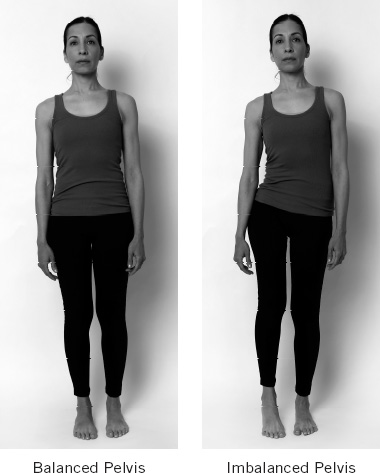
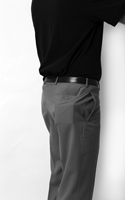 Pelvic imbalance can be caused by something simple, such as having your wallet in your back pocket and sitting on it all day. Even a tiny imbalance such as this is enough to tilt your pelvis and create reverberating back pain! Take a look at this man. You can see how the wallet in his back pocket bulges! Sitting on this causes one glute to be raised higher than the other:
Pelvic imbalance can be caused by something simple, such as having your wallet in your back pocket and sitting on it all day. Even a tiny imbalance such as this is enough to tilt your pelvis and create reverberating back pain! Take a look at this man. You can see how the wallet in his back pocket bulges! Sitting on this causes one glute to be raised higher than the other:
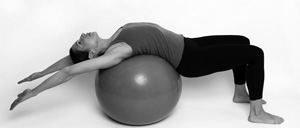
If structural treatments don’t seem to work, there could be some other factors. The muscles that stabilize your pelvis relate to the adrenal glands, or your stress glands. When your body is under stress (either from emotional or nutritional causes), the pelvic stabilizing muscles become compromised, making pelvic balance impossible. The solutions may be to change your diet, reduce your sugar intake, and ease your overall stress.
CHOKE POINT #3: The Core and Mid-Thoracic
Core/mid-thoracic imbalance is so prevalent that it is rare to find a person who doesn’t suffer from it. This is because we spend the majority of our days hunched over a computer, and our bodies get an inordinate amount of forward bending, resulting in core imbalance and too much pressure in our mid-thoracic back. Our posture develops rounded shoulders, tight chest muscles, and forward movement of our head. This has become such a workplace epidemic that “sitting is the new smoking” has become the hot new catchphrase.
My patients feel the toll sitting is taking on their body and actually see it in the mirror in their posture. “I don’t want to be a hunchback,” they say, but they seem resigned to their fate. They can’t quit their day job, after all!
The solution is learning how to engage the extensor muscles and disengage our flexor muscles to strike a balance between forward bending and back-bending.
I have developed the Backbridge™ to help put much needed extension back into our core and mid-thoracic zone. The Backbridge™ works by engaging the extensors while disengaging the overworked flexors. Pages 99-112 are devoted to the Backbridge™ (or an alternate option you may already have at home) and the ways it can ease your pain in just two minutes a day and change your life!
Other anti-flexion exercises that can help you find relief include: the cobra pose in yoga, the Thumbs to Pits stretch, or the Brugger’s Relief Position.
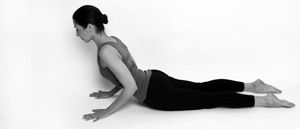
The cobra pose in yoga
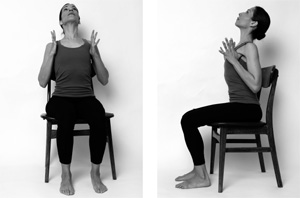
The Thumbs to Pits stretch
BRUGGER'S RELIEF POSITION
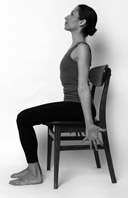
Don’t just sit there
Essentially, sitting compresses the body, stacking one spinal disc on top of another. Our muscles, which are designed to move, are now resigned to a state of stagnant contraction! To help your muscles relax and stave off core/mid-thoracic imbalance:
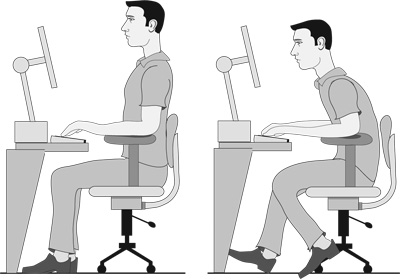
Correct vs. incorrect office chair position
Sitting Pretty
Sitting is hard on the body and since you often don’t have a choice in what type of chair you use, you should look into other solutions to help you maintain a healthy core. Here is my list of seats that are bad for us and the ways to maintain a healthy core/mid-thoracic while sitting in them:
Stools: Good posture and stools, whether at the bar or your kitchen counter, do not go hand in hand. Because most people curl over and lean on the bar or counter, stools reinforce the compression factor. Instead, sit up on the stool with your pelvis tipped forward slightly. The waist is not a hinge, so don’t bend there. If your feet are suspended, rest them on a rail under the stool.
Restaurant Booths: If they are narrow enough to let you lean back or if they are firm enough that you can perch forward, sit, again, with your pelvis tilted forward and shoulders back. Ideally, restaurants with bench seating will provide pillows that you can place behind your back, allowing diners to “custom fit” their seat.
Molded Seats: These seats, found on buses and in some restaurants, are designed to crunch the pelvis toward the torso, which is not good for you! If you’re forced to sit on one of these, perch forward and sit up straight.
The Couch: We all need somewhere cozy to curl up, but it is healthier for your spine if you prop the pillows behind you to create support for your back. A slight backward tilt is ideal!
If you are going to be sitting, find a chair that reclines back such as a
La-Z-Boy. A reclined chair lengthens the spine, eliminating a good amount of the harmful effects of sitting.
CHOKE POINT #4: The Neck
Most people forget to discuss the role the neck plays in back pain. The neck represents the top of the spine, which is intricately linked to the entire body. Nerves exiting the neck travel throughout the spine, so an imbalance within the neck can cause both upper and lower back pain. The neck’s job is to support the weight of your head. A helpful analogy is that the head should sit on your neck like a golf ball would sit on a tee. Since your head weighs about the same as a bowling ball, the proper alignment and balance in your neck is really important. A neck and head not in alignment can easily lead to pain. If this goes on for a prolonged period of time you may get significant amount of pain. It is as if your head becomes too heavy for your neck to support!
Balance in the neck is also particularly important because the neck controls the messages that go to and from the brain and the majority of mechanoreceptors in the body. Mechanoreceptors essentially tell your body where you are in space, so a neck imbalance can cause dizziness and balance issues.
Neck pain can begin from a trauma such as a fall or a motor vehicle accident or just from day-to-day activities, such as sitting in front of a computer for hours at a time. One of the most frequent causes is what I call the dreaded “Shoulder Phone Clamp.” Today, I have many more phone-pain patients than at the start of my career because everyone is now glued to their cell phone—and the phones keep getting smaller and smaller, which means we are crunching our neck more and more to keep the device steady between shoulder and ear. This simple move, when done repetitively, intensifies the tension in the neck and shoulder and robs you of flexibility in that area. Symptoms from neck tension can be headaches, numbness going down the arms, pain in the shoulder and shoulder blades, low back pain, and even wrist or elbow pain.
When treating the neck, I strive to help a patient achieve a normal range of motion and flexibility. For the most part, neck pain will improve with some cervical traction (stretching or lengthening the neck), physical therapy, massage, stretching, and chiropractic adjustments. It is important to make sure that the treatment is not too aggressive at the beginning and that you ease into the stretches. My online neck video will help you get started. Before you do the stretches, see how flexible your neck is and then retest it after you perform the stretches. This way you can evaluate how much benefit you received. Over time, these stretches should have a profound impact on your neck flexibility.
Neck Stretch Sequence
This quick sequence give you a light neck stretch of lateral flexion in both directions, as well as flexion, extension, and rotation:
1. Lateral Flexion
Sitting up tall, gently bring your right ear to your right shoulder. Place your right hand over your left ear and gently guide your head toward the right shoulder. Hold for ten seconds. Repeat on the other side.
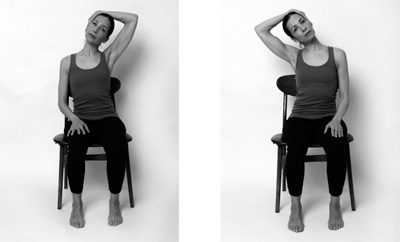
2. Flexion
Sitting up tall, bring your chin toward your chest, place your fingertips behind your head, and guide your head forward toward your chest. Hold for a count of ten.
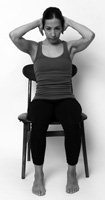
3. Extension
Now, bring your chin up. Gently place your hands on the back of your head and let your head fall further backward. Make sure that this stretch is comfortable and that you are not getting lightheaded or dizzy. Hold for a count of ten and bring your head forward again.
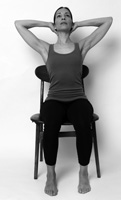
4. Rotation
Sitting up tall, turn your chin toward your right shoulder. Then place your right hand on the left side of the face and gently guide your head and chin to the right shoulder. Hold for ten seconds then repeat on other side.
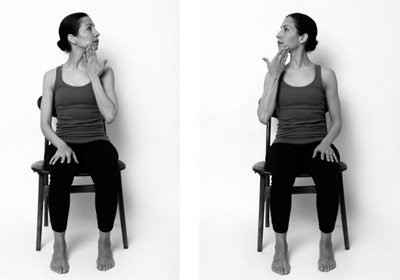
Other possible solutions include:
Backbridge™. A lot of neck pain comes from poor posture and forward rounded shoulders. The Backbridge™ restores much-needed extension into your back, helping that shoelace effect in the neck.
Mouth guard. TMJ dysfunction will frequently cause neck pain, so using a mouth guard when you’re sleeping at night can help alleviate pain originating in the jaw that radiates down to the neck. They are available over the counter and custom molded.
Try a proper pillow. When sleeping, ideally you want your head to be lower than your neck so that the head and neck can completely relax. Some posture-pedic pillows have dips in the center to allow the neck to be held up in high support. The only problem with these pillows is that as you move around in the night, your neck and head don’t always wind up in the correct position, rendering these pillows ineffective. The solution is a water pillow; the water will get displaced to properly support your neck and head, no matter which way you move! Chiroflow water pillows is my favorite brand, available at chiroflow.com.
Investing in a headset. Goodbye Shoulder Phone Clamp!
Try your own TENS Unit. For tight and stiff muscles in your upper back and shoulders as well as your lower back, try a TENS Unit. TENS Units are able to mimic the effects of electrotherapy to the muscles safely in your own home, helping to reduce pain and inflammation all throughout the body. The one I recommend is made by Trumedic.
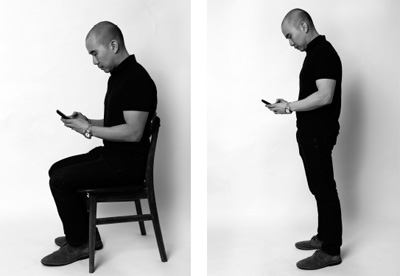
Improper device use
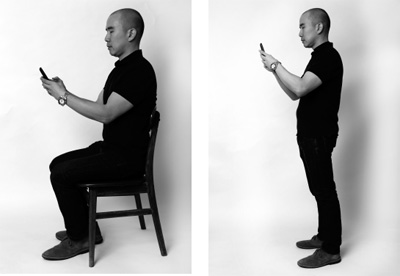
Proper device use
CHOKE POINT #5: Temporal Mandibular Joint or TMJ
The jaw joint happens to be one of the most important joints in the entire body. It is where the mandible (your jaw) meets the temporal bone (a bone in your skull right above your ear), hence the name the temporal mandibular joint. There are about a half dozen muscles that connect throughout the jaw. These muscles need to be in balance with equal pull from each of these muscles. When the TMJ joint does not move in a synchronous or smooth manner, a myriad of symptoms will appear, including jaw pain, headaches, ear pain, and yes, back pain—in both the lower and upper back and shoulders. Typically, patients with TMJ-related back pain will report feeling stiff and tight all throughout the back and spine. They will also frequently exhibit an inability to adequately open their mouth and may find that their jaw clicks or sometimes gets stuck in position. A TMJ sufferer may also clench or grind his or her teeth, either when awake or sleeping. Clenching your teeth while you are awake is a normal physiologic reaction to stress and is part of a body’s natural “fight or flight” mechanism. The problem is that a stressed TMJ releases hormones such as cortisol, which raises the inflammatory factor in the body. This results in fatigue and pain, not just to the TMJ joint but to your entire body.
If you answered “yes” to these questions in the Back Pain Inflammatory Index, TMJ is probably a cause for your pain.
These self-tests are effective in confirming at TMJ diagnosis:
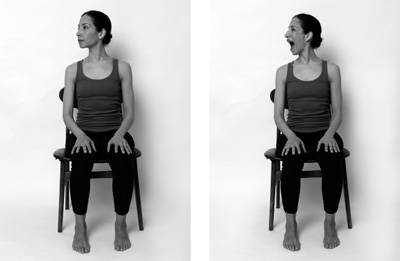
Now that you are aware of your TMJ issue, be cognizant of your clenching. Soft tissue or muscular techniques such as stretches and massage work well to balance these muscles and keep them loose. You can do one on your own by placing your hands gently on the TMJ muscles and opening and closing your jaw. Do the same stretch while putting your hands on your temporalis muscle. Do ten reps, three times a day. You can also give your jaw and the temporalis a good massage by using a micromassager for one or two minutes, as shown at the bottom of the facing page. The one I use is a Rolyan® Micro Mini Massager from Patterson Medical
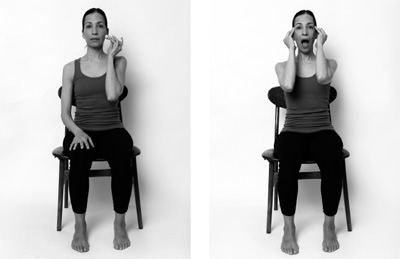
Backbridge™ is also important to integrate into your daily routine for this kind of pain because a good amount of TMJ discomfort could be a result of poor posture in the neck and shoulders. Improving your posture goes a long way in reducing the tension in the jaw.
Remember, TMJ is often caused by stress, so stress management techniques tend to be helpful.
Combined, these TMJ solutions will help you target the source of your TMJ and find relief within three weeks!
• • •
I WENT TO Dr. Sinett complaining of headaches, neck and shoulder tightness, and some overall achiness. I was under a lot of stress and was waking up feeling sore throughout my entire body—almost as if I had a really hard workout, but I hadn’t. My mouth and teeth also hurt. After touching my jaw, Dr Sinett surmised that I was clenching my teeth a lot. I was told to try a mouth guard, which I got from the drugstore and molded myself. After wearing it for one night I couldn’t believe the difference. My symptoms were significantly better. I wear my mouth guard now every night, and it has made a huge improvement in my life. I urge anyone who may feel similarly to try it—it may be the best $20 you ever spend.
Isabella Ibragnov